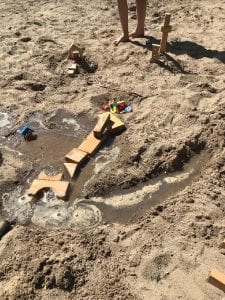9/16 Oh Gosh Dam It!
 On Thursday my class played Dam It! Dam It is where we turn on the hose at the beach and we watch the water travel around. Then we can build river paths for the water to follow. Before we turned the hose on my science teacher Shane said that she had forgotten her wooden blocks upstairs and that if someone ran up and got them we could build some buildings and see if they would be knocked down. So I volunteered to go and Harper came with me. When we got back down we all got to build houses wherever we wanted. I put mine in front of the hose. When we turned it on it spurted and knocked down my house! After that we watched the water for three minutes without touching anything. Then when the time was up we started to dig paths in the sand for the water to follow. Dylann and Lauren started to build a path going to the water and so did I, but in different places. We connected the paths coming strait from the water to ours. After a bit both of us got our water to go to the lake.
On Thursday my class played Dam It! Dam It is where we turn on the hose at the beach and we watch the water travel around. Then we can build river paths for the water to follow. Before we turned the hose on my science teacher Shane said that she had forgotten her wooden blocks upstairs and that if someone ran up and got them we could build some buildings and see if they would be knocked down. So I volunteered to go and Harper came with me. When we got back down we all got to build houses wherever we wanted. I put mine in front of the hose. When we turned it on it spurted and knocked down my house! After that we watched the water for three minutes without touching anything. Then when the time was up we started to dig paths in the sand for the water to follow. Dylann and Lauren started to build a path going to the water and so did I, but in different places. We connected the paths coming strait from the water to ours. After a bit both of us got our water to go to the lake.
I learned that people would fight about water and that some people pay a little amount of money to suck as much water as they want from the Great Lakes. I loved to see how the ripples in the water formed if there was a root in its way. I had dug a long path to the lake for the water to follow and helped connect some other paths as well. If I had done something differently then I guess it would have been making my paths as strait and thin as I could so the water would travel faster. What makes water ripple the way it does? If we put the hose in a different spot would the water travel the same way? What makes the clay in the sand turn into foam?
Josie this is an awesome post! Thank you for volunteering to run upstairs:). I like how engaged, observant and thoughtful you were about this project. That you discovered that the more narrow the channel the fast the water flows was great. How do you think this might apply to Hurricane Florence?
I think the foam comes from lighter sediment particles collecting in the water and floating on top.